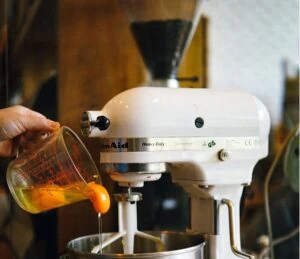Did you just purchase that new nonstick pan that you’ve been eyeing? Before using it, you should always season the pan so you’re cooking like a chef. Everybody needs a nonstick pan in their kitchen. They’re essential for making the best-fried eggs, and frying the best fish is easy with the best non-stick pan.
Cooking with a non-stick pan is also great for keeping you healthy because it doesn’t require as much butter or oil to prevent food from sticking. As efficient and easy as having a non-stick pan is, how do you season it? Here’s everything that you need to know about seasoning a non-stick pan.
What Are Non-Stick Pans?
Non-stick pans are stainless steel or aluminum cookware that has been coated with a non-porous substance that creates a smooth and glossy surface that stops food from sticking to your pan.
The most common nonstick coating used is PTFE (polytetrafluoroethylene), also called Teflon. The other common types of non-stick coatings for pans are ceramic or silica-based gel. Both types of coatings are ideal for preventing food from sticking to your pan.
Should I Season My Non-Stick Pan Before Using It?
Before you use your non-stick pan, you should season it. Seasoning a non-stick pan will help fill in any tiny pores or pits on the pan’s surface; seasoning helps fill in the inconsistencies in the non-stick coating. By seasoning your pan, you also reduce the need for oil when cooking.
Another great reason to season your non-stick pan is to make the pan last longer. The oil used to season your non-stick pan helps build a protective layer against oxidation. This prevents rust from building on the surface of your pan.
Some manufacturers recommend that you season your non-stick pan at least twice a year to ensure it stays in excellent condition. Other manufacturers will recommend that you season your pan every couple of weeks. It all depends on what type of pan you have and who manufactured it.
How to Season a Non-Stick Pan
How to season a non-stick pan is incredibly simple and requires only a few minutes of your time:
- Use dish soap and warm water to wash your pan to remove any dirt and packaging residue.
- Thoroughly dry the pan with a paper towel or clean cloth.
- Season the non-stick pan using one teaspoon of canola or peanut oil. Rub the oil into the pan surface up to the rim.
- Heat the non-stick pan on the stove over medium heat for 30 to 60 seconds.
- Remove from heat and let the pan cool and dry thoroughly.
- Using a paper towel, wipe out any excess oil.
Congratulations, you now have a successfully seasoned pan!
Seasoning a Non-Stick Pan in the Oven
You can also choose to season your non-stick pan in the oven, and the results are the same as if you were to season your pan on the stove.
- Preheat your oven to 300 degrees F.
- Pour one teaspoon of peanut oil into the non-stick pan. Using a paper towel, spread the oil all over the surface of the non-stick pan – including the rim.
- Place the non-stick pan inside the oven for an hour.
- Remove the non-stick pan and let it cool down completely.
- Use a paper towel to wipe away any excess oil.
What Happens If I Don’t Season My Non-Stick Pan?
If you don’t take the time to season your non-stick pan, food can stick to the surface and burn. You’ll also find that you have to start adding oil when you cook to prevent food from sticking to the pan’s surface, which defeats the purpose of a non-stick pan.
Once any food starts to stick to your pan, it can be challenging for your non-stick pan to work at its best. When you notice food starting to stick, it’s time to season your non-stick pan.
Can I Use Olive Oil to Season My Non-Stick Pan?
No, olive oil shouldn’t be used to season your non-stick pan, even if some manufacturers say this is okay.
This is because olive oil has a low smoke point, meaning that the oil will start to break down at medium to high temperatures and start smoking. Avoid using any other oils with low smoke points or butter to season your pan.
The best oil to use when seasoning your non-stick pan is peanut oil because it has a very high smoke point.
Benefits of Cooking with a Non-Stick Pan
There are some fantastic benefits to cooking with a non-stick pan, including:
- The most significant benefit is that they’re healthy to cook with because you can cook with less butter and oil. This is because food doesn’t stick to the non-stick Less oil and butter equal fewer calories and fat.
- A non-stick pan will save you time when you’re cooking because you’ll spend less time cleaning the pans after cooking.
- Heat is evenly distributed throughout the non-stick pan, so food cooks faster and uniformly, enhancing the flavor.
- Fried and breaded foods are easy to cook in a non-stick pan because the non-stick surface prevents them from falling apart without using a lot of oil.
- Delicate food, such as fish and fried eggs, will also stay in one piece when you cook them in a non-stick
Now that you have a seasoned non-stick pan, you can go ahead and start cooking delicious meals for you and your entire family! Be sure to season all of your non-stick pans to reap the most benefits.











